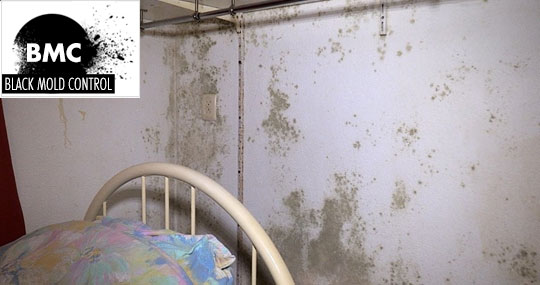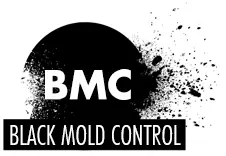Are you breathing toxic black mold while you are sleeping? Black mold is a danger in any area of the home. When it is in your bedroom, you are exposed to it for many hours while you are asleep. This leaves you vulnerable to the dangerous spores released throughout the night. It is important to understand black mould and how to identify it. Although it can be hard to notice when hidden around the bedroom. There are certain areas where black mold is more likely to be found.
This information will help you understand black mold and how to find out if it might be in your bedroom.

Table of contents
Is mold in bedroom dangerous?
Stachybotrys chartarum or black mold is a type of microfungus that releases spores and mycotoxins that have been found to be toxic in humans and pets. This mould can be green or black and often has a musty or mildew smell. Mold grows well in any area that is warm and damp. Even exposure to small amounts of moisture can promote growth. Once the colony is established, it releases more spores and mycotoxins into the air.
The bedroom is the room of the home where people spend the most time in. During this time spent in the bedroom, people are often asleep and breathing deeply throughout the night. This puts them at a higher risk of breathing in the toxins created by this mould.
What causes mold in your bedroom?
There are small amounts of mould spores in the air and on various surfaces almost all the time. When conditions are right, these spores can begin to grow and create colonies that produce more spores to continue their growth cycle. If a bedroom is very humid, has had water damage, or is exposed to dampness, it can create the perfect environment for these spores to grow. High humidity or condensation in the bedroom can create enough moisture to grow. Most people do not even notice the first signs due to the area or miniscule colony in obscure areas of the room. Often, this growth can go unnoticed until it has become a major problem.
Do you want to know more? Read our in-depth articles about: mold growth.
Where to look for mold?
Mould can be difficult to spot in a bedroom. Since there are various furnishings and decor in the room, mould can be hard to find. Low lighting in the bedroom also makes it harder to find the growth. It is important to thoroughly inspect every part of the entire room. Additional lighting may be beneficial in identifying any potential areas. The room should be examined from every part of the ceiling to the corners of the walls. Any area that has been known to have had moisture or water damage should be inspected first.
It is also important that every corner and area of the room be thoroughly examined for the tell-tale signs. Thoroughly inspect the ceiling, the walls, the windows, the mattress, and even the closet and clothes inside.
Ceiling
Thoroughly inspecting the ceiling for any spots of green or black is very important. The ceiling is a prime area for mould to grow in the bedroom. A leaky roof or condensation in the attic can create the dampness needed for colonies to begin in a ceiling. You should check the entire area of the ceiling for water stains or other signs of dampness. Each corner of the ceiling should also be thoroughly inspected for any moisture or spots. Sometimes, mould can look like dirt spots or other specks, it is important to get a good look at any of these spots to see if they could be early colonies.
Recommended article: Black mold on ceiling
Walls
Each of the walls of the bedroom should also be completely examined for any signs of a problem. Any walls that have water pipes in them or are exposed to moisture from the bathroom could be a candidate for spores to grow on the walls. Water stains or black spots on the walls could be an indication of growth. Unfortunately, mould can also grow on the inside of the walls. It is important to look for changes in the surface or signs of deterioration, such as cracked or peeled paint. Unfortunately, most walls in the home are drywall. Drywall is very porous. If infected, these walls, or portions of the drywall, may need to be removed.
Windows
Although most people would not suspect the windows in the room to be a likely place for a problem, the windows are often a common area for colonies to form. When temperatures are greatly different between the inside and the outside of the home, there is potential for condensation to form on or around the windows. This condensation on or around the windows provide the perfect amount of moisture for the problem to begin.
Mattress
Another area that may go unnoticed is the mattress. It is most important that you check the mattress since you sleep on it every night. Small spills, high-humidity, and even drooling in your sleep can create moisture in the mattress. Just a tiny bit of moisture is all it takes for the problem to begin. To inspect the mattress, remove all bed coverings and thoroughly inspect the entirety of the mattress. Make certain to check both sides and around all seams.

Closet and clothes
Your closet may also be hiding this toxic substance from you. Condensation can occur almost anywhere the conditions are right. High-humidity or even steam from the bathroom can cause serious damage to the closet. Even hanging damp clothes in the closet can pose a risk of colonies. When inspecting this area, it is important to thoroughly check the ceiling and any drywall for spots or stains. It is also a good idea to check the clothes for spots or if they smell musty.
How to remove black mold in bedroom?
Removing mould in your bedroom can be complicated. It has always been recommended that a person use bleach to remove mold. However, bleach must be used in the proper concentration to have any effect on mold growth. In addition, bleach can only be used on hard, non-porous surfaces. Bleach used on porous materials is not very effective. The bleach can seep into the porous materials and cause damage to these items. Bleach also loses its effectiveness after some time. This can create a new damp area for mould to grow.
Good read by North Dakota State University: PDF.
Porous materials that have mould should be removed and disposed of. This is because the mould growth gets deep inside of these materials and it can make it impossible to complete remove the mold. Missing any mould during the cleaning process can cause further growth.
Hiring a professional to handle the mould removal in the home is probably the most effective method for homeowners.
Are sleep problems and mold connected?
There has been a major connection between this infestation in a bedroom and sleep issues. Some of the mycotoxins that are released have been shown to cause respiratory problems. Snoring and sleep apnea are common complaints of those sleeping in an infected room. This can often lead to fatigue due to not getting enough sleep during the night. Those with allergies or sensitivities to such things may experience worsened symptoms sleeping in the room.
Mold prevention tips
The best prevention tip is to keep things as dry as possible. Any spills in the room or on the mattress need to be thoroughly dried immediately. Clothes should never be hung in the closet wet. A leaking roof or water pipe should be repaired immediately. After repairs are complete, the area should be thoroughly dried to prevent the problem from starting. If the room is often humid, a dehumidifier may be the best option. This can also help reduce condensation in the room.
Consult a mold remediation professional
Black mold can be difficult to identify. If black mold is suspected in your home, you should contact a mold removal professional. A removal professional is trained to identify problem areas and can offer a free quote for removal.
